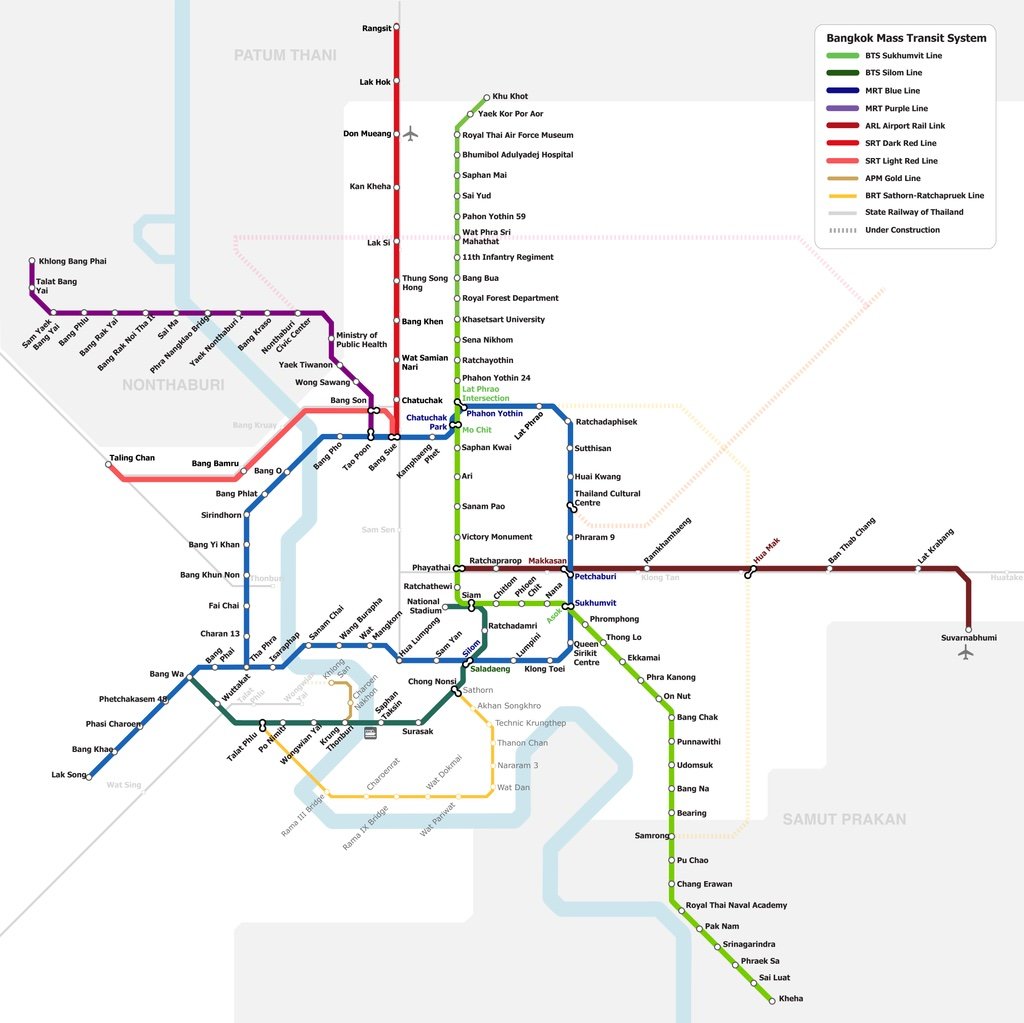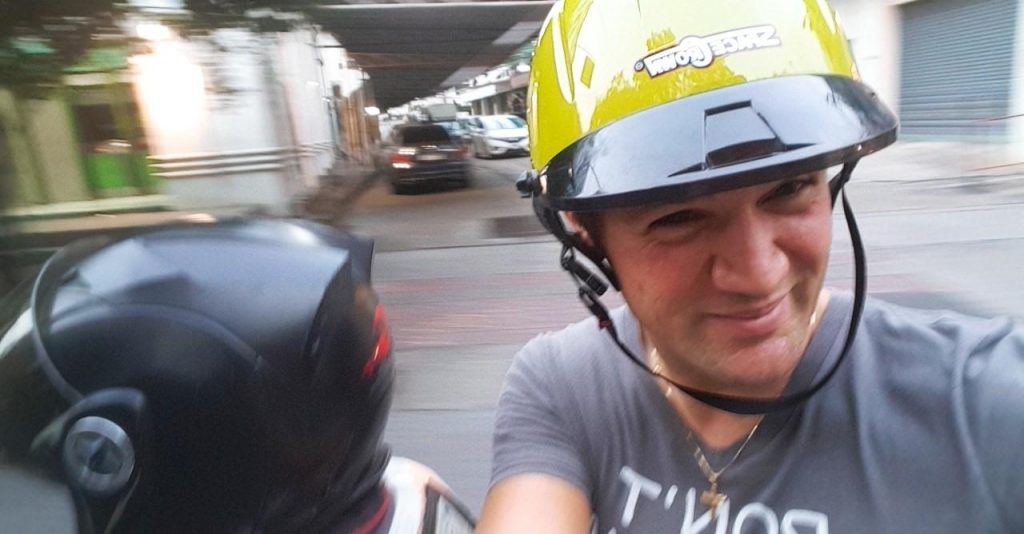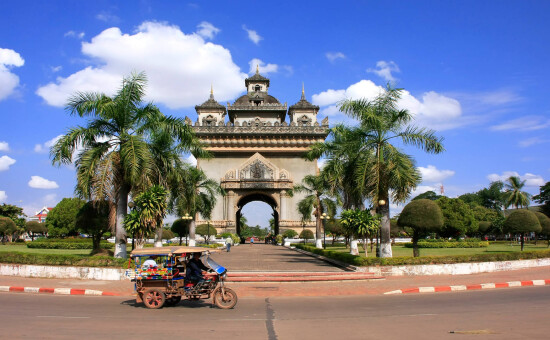Bangkok transportation: How to get around Bangkok
Got Bangkok on your itinerary but don’t know how to get around? This comprehensive guide to Bangkok transportation is everything you need.

Bangkok transportation can be a tough nut to crack.
Tuk-tuks honk as motorcycle taxi drivers deftly weave through traffic. Taxis pull up to the curb as orange buses idle, billowing black clouds of diesel exhaust in the midday heat.
The BTS Skytrain in Bangkok rumbles overhead as the MRT hums quietly below ground.
Beneath the smog and commotion, an endless list of things to do in Bangkok awaits. Think jumbo-sized shopping malls, mouthwatering Thai food beckoning everywhere, and sky bars offering bird’s eye-views of the riverside. But how do you get from one place to another without losing your sanity?
To help you navigate through the concrete jungle, this is how to get around Bangkok.

Use the Airport Rail Link (the best Bangkok transportation out of the airport)

You’ve claimed your checked luggage; where to next?
You can ignore the taxi touts and people lining up for a meter taxi. Instead, ride the Airport Rail Link (the Bangkok airport to city train). You’ll get from Suvarnabhumi’s B1 floor to downtown Bangkok within 26 minutes. That could never happen in a taxi. There is far too much traffic.
Since the Airport Rail Link fare from Suvarnabhumi to downtown is about 55 baht ($1.70), you can save the farang taxi premium for your tuk-tuk ride to Khao San Road, the famous backpacker street.
The Airport Rail Link runs daily from 6 am to midnight, with regular trains departing from Suvarnabhumi airport every 15 minutes.
At Phaya Thai (A8), the Airport Rail Link’s final station, there’s a BTS interchange to connect to the BTS Skytrain system. But you can also get off earlier at Makkasan (A6), and use the skywalk to get to the MRT station at Petchaburi and jump on an MRT train there.
So, the Airport Rail Link will, erm, link you to pretty much anywhere and any transit line in Bangkok.
Save time on the MRT

Unlike the Skytrain, the MRT Bangkok is rarely crowded. The subway’s rapidly expanding lines are air-conditioned and welcome in the Bangkok public transportation network. Fares are dirt cheap at 16 baht ($0.50) or a maximum of 42 baht ($1.30). The MRT is connected to the BTS lines with interchanges at Sukhumvit, Silom, and Chatuchak, where Thailand’s largest weekend market awaits with over 15,000 stalls.
Currently, you can jump on two subway lines from 6 am to midnight.
The purple line from Tao Poon to Khlong Bang Phai takes you to Nonthaburi’s Victoria Water Lily Malai Garden to stand on giant lily pads.
And the blue line from Bang Sue to Lak Song takes you to several central locations like Silom and Sukhumvit.
An MRT Bangkok map will help you get through the Metropolitan Rapid Transit system.
Jump on the BTS Skytrain

The BTS, or Bangkok mass transit system, is an effective means of transportation in Thailand.
There are two main Skytrain Bangkok lines; the light green Sukhumvit line between Khu Khot and Kheha and the dark green Silom line running from National Stadium to Bang Wa.
National Stadium is where you’ll want to get off if your answer to “What to do in Bangkok” is shopping. MBK, the shopper’s paradise in the heart of Bangkok with more than 2,000 shops, is a must for trendspotters.
The BTS in Bangkok also offers a driverless gold line connecting the Silom line with Icon Siam, another upscale shopping mall. The BTS operates from 5:15 am until midnight, and tickets cost between 16 baht ($0.50) and 59 baht ($1.80). Depending on how often you use the Skytrain, you might save a few baht if you buy a one-day pass for 140 baht ($4.30).
The elevated rapid transit system spares you Bangkok’s gridlocked streets. You’ll find the BTS Thailand map in the BTS app.
While the BTS network keeps expanding, it’s best to hop on a ferry at Sathorn Pier near BTS Saphan Taksin to get to Rattanakosin Island, Bangkok’s Old Town. It’s where a lot of the famous sites are like the Grand Palace, Wat Pho (Temple of the Reclining Buddha), the Chao Phraya River and Khao San Road are.
Jump on a ferry

River ferries are an excellent option if you’re looking to quickly get to Wat Arun, the pyramidal, Chinese porcelain/glass-covered temple, or Chinatown.
Canal boats run from 5:30 am to 7:15 pm on weekdays, 6 am to 6:30 pm on Saturdays, and 6 pm on Sundays. They’re almost free at 15 baht ($0.45), but note they pull into piers only for a few seconds, so be quick.
Also, as they stop at every station, you might be better off hopping on the blue-flagged tourist boat, which costs 60 baht ($1.85). It runs daily from 9:30 am to 5:30 pm and stops only at sightseeing piers.
You can also use orange-flagged boats and cross-river ferries, plus private long-tail boats; most start at Sathorn Pier. While it can get hectic at rush hour, feeling the wind in your hair and getting a breath of fresh air is a welcome change from traveling amid a sea of exhaust pipes.
Ride a Motorcycle Taxi: The craziest Bangkok transportation

If getting around Bangkok fast is your priority, motorbike taxis, or motorsai, are for you. Period.
While not as safe as other transportation in Bangkok, it’s pretty cool to avoid bumper-to-bumper congestion. Just smile in a mai-pen-rai-it-doesn’t-matter-fashion if the brazen rider in his bright orange vest uses sidewalks as motorcycle lanes, jumps red lights, or travels against the traffic flow.
That’s not to say all of them flout traffic laws, and some guys even give you a helmet to strap on. Either way, you can easily find motorsai at the end of sois, side-streets branching off major roads.
To make this type of public transportation in Bangkok hassle-free, don’t ride pillion with your legs to one side like some Thai ladies, and agree on a fare before you hop on. Prices range from 20 baht ($0.60) for very short distances to some 150 baht ($4.60) to crisscross the city and quickly increase by about 20 baht for each Bangkok BTS station you pass.
Save even more when you ride a Grab motorcycle taxi

Even cheaper than motorcycle taxis are Grab (Uber-like) drivers. Grab will save you 25-50% off what you’d pay for a regular motorbike taxi.
While you quickly get the hang of pinning your location, it gets more complicated when the driver calls you to ask in Thai where you are.
Use taxis as Bangkok transportation

First-time visitor to Bangkok? We get it.
While taxis are prone to traffic jams, imagine how comfortable it is to sit in an air-conditioned cab, your backpacks stowed away in the trunk, and nobody coughing nearby with their mask below the nose or chin.
They’re also relatively cheap as long as your driver has turned the meter on. And insist they do. The basic charge is 35 baht ($1.10). Also, factor in freeway tolls between 25 baht ($0.75) and 120 baht ($3.70), depending on where you begin and end your taxi ride.
Have fun on a tuk-tuk—the most iconic Bangkok transportation

Thais rarely use Bangkok’s motorized three-wheel taxis unless they’re market vendors carrying loads of goods. To foreigners, tuk-tuks are a noisy but fun part of the Thailand experience. However, they aren’t metered and are costly—even short hops cost 100 baht ($3.10) or more.
Haggle determinedly before climbing aboard, and be wary if you get a too-good-to-be-true-fare as there are scams.
You can flag tuk-tuks down anytime, anywhere.
There are also local buses and the BRT bus system between Sathorn (near BTS Chong Nonsi) and Ratchaphruek. While buses have their own lanes, Thai reading skills are an advantage.
Lastly, you can explore the city on foot and see what you stumble across. You’ll likely discover local life down a backstreet, where the pieces of the Bangkok puzzle fall into place.
No matter what Bangkok transportation you choose, getting around this massive city is an adventure in itself and probably just the beginning of your Thailand itinerary.
FAQ
It can be challenging at first, but once you get the hang of public transportation, it’s pretty easy compared to other metropolises like Singapore.
While not everyone’s favorite, hands down the speediest travel method in Bangkok is motorsai, or motorbike taxis.
Ride the Airport Rail Link train at the B1 floor to Phaya Thai, the final station (it takes 26 minutes to get there), and jump on a BTS Skytrain there. Phaya Thai is three BTS stations away from the station National Stadium (though change the train at the BTS station Siam), where you’ll find the MBK shopping mall.






